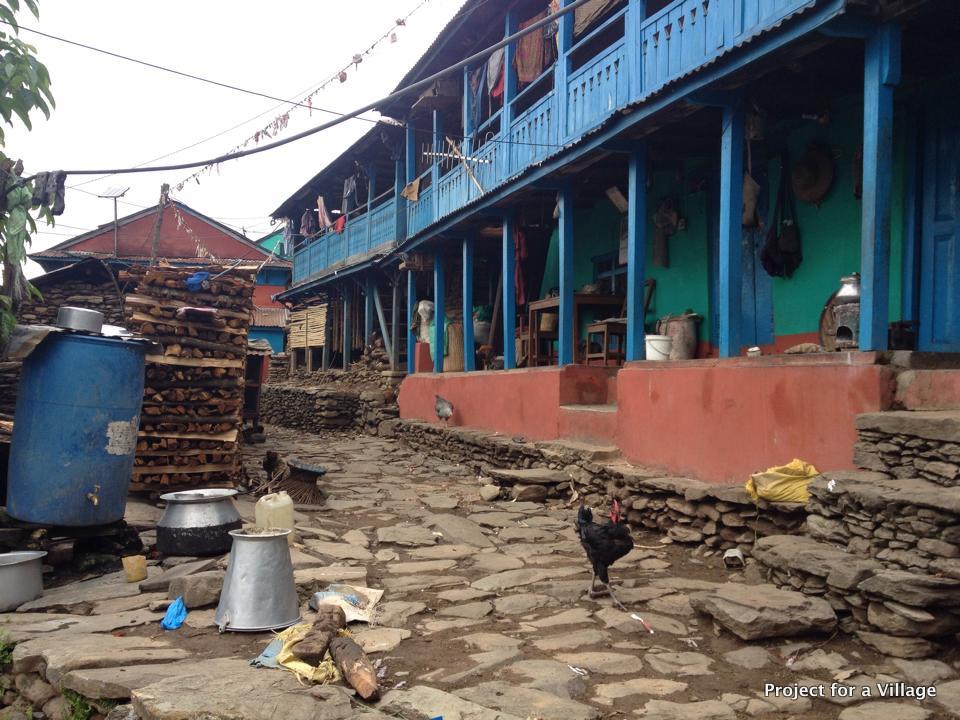By Katie & Bijaya Gurung
In Gurung culture many of the Gurung villages throw big parties and call people from other villages to come. I had never been before, but we got invited to go to a nearby village. It’s tradition to invite villages by sending young boys to each village to bring the group to the party. So a couple days ago, one boy from the village who is hosting the party was sent to Bijaya’s village to bring us to the party. The walk is around three hours I would say, down one hill, up the next. Bijaya and I were not in his village at this time, but his friend Jeewan called and told us that a bunch of the guys from the village were going and that we should come too. So we walked to Paudi (a town about an hour walk away) and met up with some of the other guys. From there we took a short bus ride and then started the walk up the hill to that village hosting the party. Our guide (who was sent to bring us) was just 12 years old, in 5th grade. He led us throughout the one and a half hour walk. Traditionally people start to arrive at the party late at night, however we were the first group to arrive around 7:30pm. Walking up the hill on the path at night was a little difficult (especially because looking off the edge of the path was a steep drop, eventually leading into a huge river. Just as we were getting close, it started raining, coating the already slippery steep path (with so many leaves covering the ground) with a fresh coat of water! We made it there just fine though, and when we arrived we were so early they weren’t quite ready for us yet. They quickly prepared tikka (a raw rice mixture used to put on the forehead as a blessing) and welcomed us. We sat underneath a large area with tarps held up by bamboo poles. After we all sat down as a group, someone brought us juice and snacks. Then all the guys from Bijaya’s village opened their bags that they had carried up and took out drums made by hand from goat’s hide. After arriving, each group would sing a sort of welcoming song to the host village thanking them for having us. After a few different songs, the guys took a break and someone from the host village brought some bottles of local wine (made from millet) for our group. Eventually more village groups showed up, some not arriving until in the middle of the night or later, and some not until the following day. Throughout the night there was constant music being played and songs being sung. All the songs are very traditional village songs and music. There was dancing, drinking, laughing, overall a great time.
Finally it was after one o’clock in the morning and our group was getting tired and almost all were laying down ready to sleep. After a while someone came to take us to different houses to sleep, as is custom for this type of party. Bijaya has said how these type of parties used to be so much bigger, so many people would come, they wouldn’t even have enough food to feed them or not nearly enough beds/ground space for people to sleep. However, since there are less people living in the villages, and so many people living abroad that when villages call other people to come for this type of party, the turnout is significantly smaller. In Nepal, Gurung people are well known for these parties, in general Gurung people are known to have a lot of fun (it probably helps a little bit that every house in Gurung culture makes their own local wine too!) These types of parties that are held once a year are especially meant to be a place for young people to meet. Girls and boys from different villages can have a chance to meet each other, and even start dating. In this sense, Gurung society is not as strict as most other castes are in Nepal. I saw plenty of young people talking to each other, watched as a couple boys danced most of the day next to certain girls just to be able to talk to them. In the Gurung caste there are also many sub-castes within it. Bijaya’s caste is Gurung, but his sub-case is Lama. This is important for young people at these parties, because if you are interested in someone, first you have to find out which sub-caste they are. If they are the same sub-caste as you, you cannot marry them as they consider everyone with the same sub-caste as their own as family, brothers and sisters and therefore is very taboo to date/marry.
In the group that came from Bijaya’s village, Jeewan was the oldest, and Bijaya next. All the other guys ranged in age from 15 to 22. A few boys also came from Kalimati (a small town on the bottom of Bijaya’s village hill), their families originally were from the same village but moved to that lower town. It was so interesting to see the same age boys from the town versus the village in the setting of the party. The boys from the small town didn’t know how to play the drums well, and didn’t know many of the traditional songs. The biggest difference however was respect, the young guys from the small town were more like most American teenagers, rebellious and not listening to any advice and doing whatever they wanted. However, the same aged boys from the village were so respectful, and seemed much more mature. I think everyone can agree that most boys of that age everywhere in the world don’t listen to their parents very well. However, the difference with the village boys, was that while that might still be true, they listen to the older guys in the village (Jeewan, Bijaya, etc) with the utmost respect, and do whatever the guys say. They are helpful, without asking. They carry a bag when asked (a pretty heavy one at that, uphill, and all the way home) without any complaints. They don’t smoke near me (they all know I’m not a fan of smoking…I’ve tried to convince many to quit…), and they stop drinking if told. They understand that at these type of parties everything they do is representing their village, Chock Kot, and they take pride in that. It’s a rare kind of respect, and it was great to witness it. I hope that somehow that tradition can carry on even though so many people are moving out of the villages.
We stayed one night in that village, and in the afternoon we were getting ready to leave. First we had to all go gather and decide how much money to give to the village for hosting (providing food, drinks, shelter, etc). Then you have to place all the money on a plate (traditionally also filled with rice and some flowers) and then again there is a certain farewell song, thanking the host village. The drums started, the song was being sung, and then everyone from the group got up and circled the women who were dancing at the front. One guy from the village tried to give the plate of money, but no one wanted to accept it- showing politeness and also because they didn’t want us to leave. Finally at last, they accepted it, the song was over and we were on our way. Or so we thought. We said our thank yous and goodbyes and started walking down the path, only to be stopped by women and children from that village, begging us to stay for just a little bit longer. (I do have to say, Bijaya’s village really did bring the party- they excel at singing and playing music). This request to come back shows a lot of respect to Bijaya’s village. After a lot of begging, and a lot of kids literally pulling us back with all their might, we went back for another hour or so. One guy at the time had come to the village (knowing about the party) to sell ice cream and popsicles. Many people were buying popsicles, and with it being so hot the orange frozen treat looked pretty good. So we bought some, when I licked it however the flavor was nothing like I expected. It was not an orange popsicle, only in color, I don’t know what it was flavored with, but it was interesting…haha. Again as we were leaving, it appeared more people were up towards the path attempting to block us again. So we took an alternate route through a corn field and made our escape!
We parted paths with the village guys and walked to Siudibar. It started to rain along the way, but we were lucky to catch a bus right away to Sundar Bazar. We got on the bus and I got the last seat- it’s hard to get a seat, every bus always is jam packed full of people. I gladly took the seat even though it was next to an old man who was clearly drunk. The entire ride he was full out dancing to himself in his seat. It was nice to get out of the rain, until the bus started moving and I looked up to see a leak in the bus’s roof. Have I said travel can be frustrating in Nepal? Haha.






